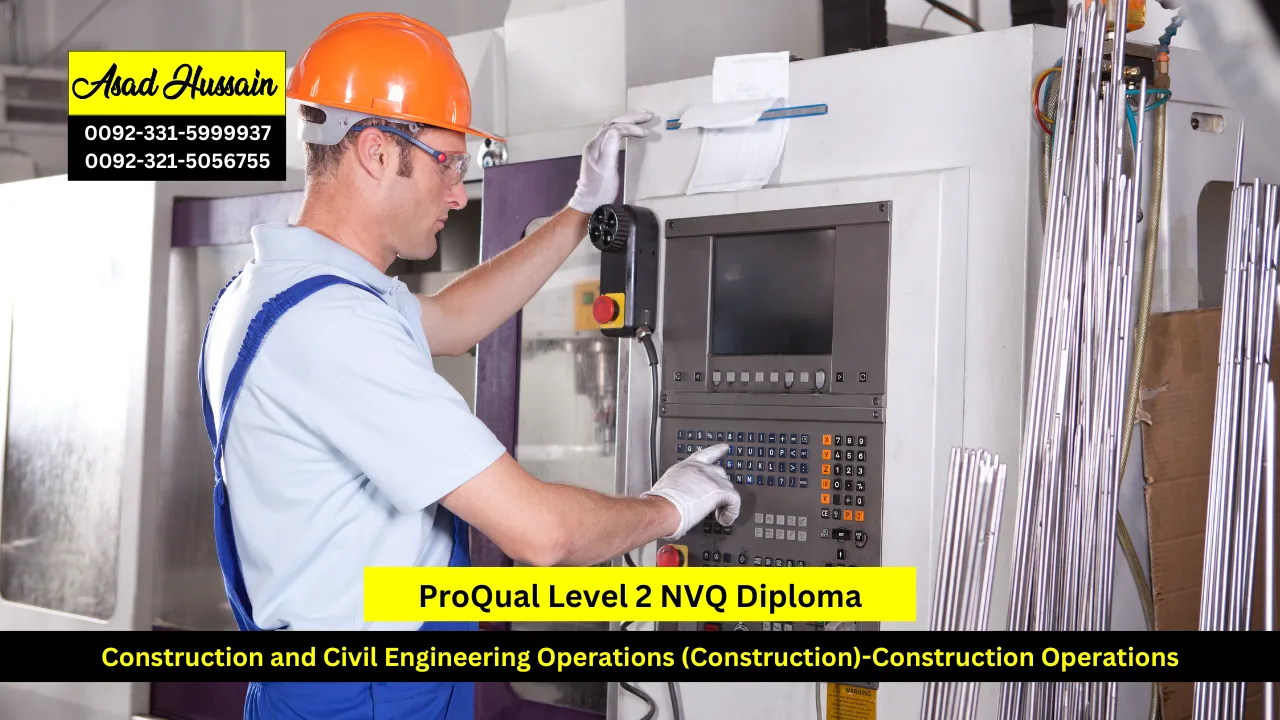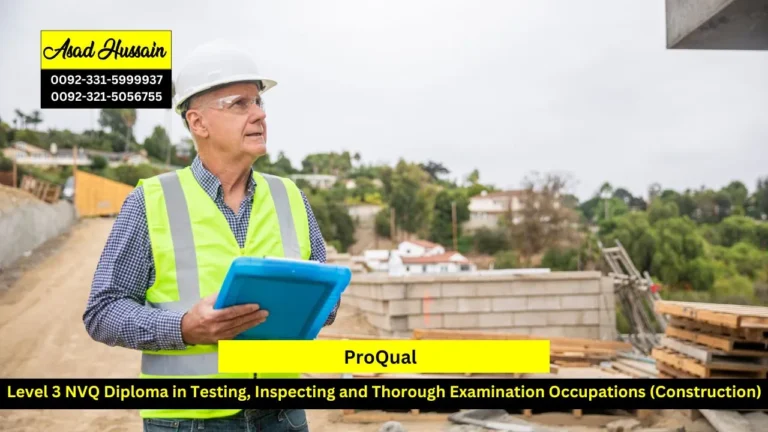The ProQual Level 2 NVQ Diploma in Construction and Civil Engineering Operations (Construction)-Construction Operations is a practical, work-based qualification designed to formally recognise the skills of those working on-site in various construction and civil engineering roles. The construction industry continues to grow, with increasing demand for skilled workers who can demonstrate both knowledge and practical experience. If you’re already working in construction and want to take your career to the next level.
This ProQual Level 2 NVQ Diploma in Construction and Civil Engineering Operations (Construction)-Construction Operations is tailored for construction operatives who are actively involved in groundworks, drainage, concreting, and other core civil engineering operations. This ProQual Level 2 NVQ Diploma in Construction and Civil Engineering Operations (Construction)-Construction Operations provides a structured pathway for demonstrating occupational competence and meeting industry requirements, especially in line with CSCS card applications.
The ProQual Level 2 NVQ Diploma in Construction and Civil Engineering Operations (Construction)-Construction Operations offers an accessible and effective route for recognising and validating the essential skills of construction operatives. This ProQual Level 2 NVQ Diploma in Construction and Civil Engineering Operations (Construction)-Construction Operations is an excellent investment in career development for anyone working in groundworks, drainage, or concrete-based operations within the UK’s construction sector. The ProQual Level 2 NVQ Diploma in Construction and Civil Engineering Operations – Construction Operations is your stepping stone to a more secure and rewarding career in construction. Whether you’re a groundworker, labourer, or general operative, this qualification gives you the recognition you deserve and opens up new possibilities.
Program Highlights
Mandatory Units
The ProQual Level 2 NVQ Diploma in Construction and Civil Engineering Operations (Construction)-Construction Operations, to achieve the qualification candidates must complete all the mandatory units and one optional unit form the following :
- Installing, maintaining and removing work area protection and safety equipment in the workplace
- Moving, handling and storing resources in the workplace
- Conforming to general health, safety and welfare in the workplace
- Conforming to productive working practices in the workplace
Optional Units – candidates must complete one unit in this group - Placing and compacting concrete in the workplace
- Installing drainage in the workplace
- Preparing, mixing and distributing concrete and mortars in the workplace
Optional Units – candidates must complete one unit in this group - Reinstating ground condition in the workplace
- Erecting and dismantling access/working platforms in the workplace
- Cutting, drilling and shaping construction related materials in the workplace
- Laying, placing or applying construction related materials in the workplace
- Preparing and mixing construction related materials in the workplace
- Identifying and marking the location of utilities apparatus and sub-structures in the workplace 2
- Controlling, directing and guiding the operation of plant or machinery in the workplace
- Locating and excavating to expose buried utility services in the workplace
To enrol in this ProQual Level 2 NVQ Diploma in Construction and Civil Engineering Operations (Construction)-Construction Operations, candidates must meet the following entry criteria:
- Minimum Age
Candidates must be at least 16 years old at the time of enrolment. - Educational Background
There are no formal academic qualifications required to undertake this NVQ. However, a basic understanding of construction principles and site activities is beneficial. - Work Experience
Applicants must be currently employed in a relevant construction or civil engineering role, with access to real-time, site-based tasks and responsibilities. This ensures the ability to gather workplace evidence for assessment. - Language Proficiency
Candidates should possess a basic level of English to ensure effective communication on-site and the ability to understand instructions, safety protocols, and contribute to portfolio development. Proficiency equivalent to Entry Level 3 in Functional Skills or above is recommended.
These requirements ensure that learners can fully participate in the assessment process and demonstrate their competency in real construction environments.
Installing, maintaining and removing work area protection and safety equipment in the workplace
- Understand the requirements for site protection and safety signage or lighting.
- Demonstrate how to install and dismantle safety systems safely.
- Maintain equipment effectively during its use on site.
- Ensure compliance with health and safety regulations.
Moving, handling and storing resources in the workplace
- Identify appropriate manual handling techniques.
- Safely transport and store construction materials and equipment.
- Maintain the security and condition of stored items.
- Reduce risks of damage and personal injury.
Conforming to general health, safety and welfare in the workplace
- Recognise potential workplace hazards.
- Follow site-specific safety protocols and reporting procedures.
- Use personal protective equipment (PPE) effectively.
- Promote a safe working environment.
Conforming to productive working practices in the workplace
- Communicate efficiently with team members and supervisors.
- Work to agreed plans, timescales, and quality standards.
- Demonstrate team collaboration and problem-solving skills.
- Contribute to improving work productivity.
Placing and compacting concrete in the workplace
- Prepare work areas for concrete placement.
- Use correct tools and techniques for placing and compacting.
- Work to specifications using methods such as chutes, pumps, or skips.
- Ensure compaction meets structural and quality standards.
Installing drainage in the workplace
- Understand drainage systems, including inspection chambers and foul/surface water layouts.
- Install drainage components accurately to design requirements.
- Use backfilling techniques to ensure proper support and flow.
- Adhere to safety and environmental standards.
Preparing, mixing and distributing concrete and mortars in the workplace
- Identify correct material proportions and mixing techniques.
- Mix and transport concrete and mortar safely and efficiently.
- Ensure consistency and quality of mixes.
- Maintain and clean mixing equipment.
Reinstating ground condition in the workplace
- Select appropriate materials for backfilling and surfacing.
- Restore surfaces including hardstanding and grassed areas.
- Compact materials to required specifications.
- Reinstate to original or specified condition post-installation.
Erecting and dismantling access/working platforms in the workplace
- Identify appropriate platform systems for task and site.
- Assemble and secure access equipment according to instructions.
- Carry out safety checks and risk assessments.
- Dismantle platforms safely and store equipment properly.
Cutting, drilling and shaping construction related materials in the workplace
- Select tools and methods suitable for various materials like metal, timber, or masonry.
- Follow cutting plans and safety protocols.
- Produce accurate cuts and shapes to meet specifications.
- Dispose of waste material responsibly.
Laying, placing or applying construction related materials in the workplace
- Prepare surfaces for application of materials.
- Lay or apply materials like soil, geotextiles, concrete or fill.
- Ensure even distribution and bonding where applicable.
- Maintain alignment and quality throughout the process.
Preparing and mixing construction related materials in the workplace
- Select and measure components for mixing.
- Produce consistent mixes of resins, cement, grouts, etc.
- Follow safety guidelines for handling and storing materials.
- Clean and maintain mixing tools and equipment.
Installing, maintaining and removing temporary excavation support in the workplace
- Understand different excavation support systems.
- Install proprietary or custom support systems safely.
- Monitor supports during excavation.
- Remove supports ensuring excavation stability and safety.
Identifying and marking the location of utilities apparatus and sub-structures in the workplace
- Interpret site plans and utility layouts.
- Use tools to trace and mark utilities accurately.
- Follow protocols to avoid damage to services.
- Report discrepancies or unexpected findings.
Preparing and operating powered units, tools or pedestrian plant, machinery or equipment in the workplace
- Inspect tools and equipment before use.
- Operate powered units such as compressors, mixers or pedestrian machinery safely.
- Monitor performance and identify faults.
- Shut down and store equipment appropriately.
Controlling, directing and guiding the operation of plant or machinery in the workplace
- Understand banksman signalling techniques.
- Direct plant and machinery movements safely on site.
- Communicate effectively with machinery operators.
- Maintain safe distances and awareness of site activities.
Installing, constructing, maintaining, dismantling and removing temporary works in the workplace
- Plan and install temporary works including screens, hoardings, and stabilisation.
- Monitor temporary works for safety and compliance.
- Safely dismantle and remove materials when no longer needed.
- Coordinate temporary works within the wider site plan.
Locating and excavating to expose buried utility services in the workplace
- Use plans and detection tools to locate utilities.
- Excavate manually or mechanically with caution.
- Avoid damage and ensure the safety of all workers.
- Support exposed utilities during excavation activities.
The ProQual Level 2 NVQ Diploma in Construction and Civil Engineering Operations (Construction) – Construction Operations is designed for individuals working or seeking to work in the construction and civil engineering industry. This qualification is ideal for the following groups:
- Individuals currently employed in construction or civil engineering roles looking to gain formal recognition of their skills.
- Construction operatives seeking career progression through a nationally recognised qualification.
- New entrants to the construction industry who have access to relevant on-site experience under supervision.
- Apprentices undertaking a structured learning programme in construction operations.
- Skilled workers in other trades wishing to transfer into civil engineering operations.
- Employers and contractors aiming to upskill their workforce to meet industry standards.
- Those aiming to obtain a CSCS (Construction Skills Certification Scheme) card based on NVQ qualification.
- Individuals seeking a pathway to more advanced qualifications in construction and civil engineering.
This ProQual Level 2 NVQ Diploma in Construction and Civil Engineering Operations (Construction)-Construction Operations ensures candidates demonstrate competence in real working conditions, making it essential for both career starters and experienced professionals aiming for advancement in the construction sector.







